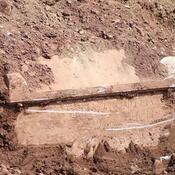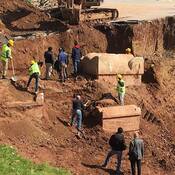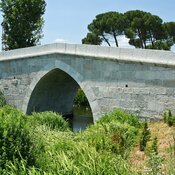Er zijn nog geen Nederlandstalige annotaties. Hier volgen annotaties in het Engels.
Nicomedia - modern Izmit was founded in 712/11 BC as a Megarian colony and was originally known as Astacus (Astakos Kolpos)1. Since the second century BC a close political relationship begins between Rome and Asia Minor and Bithynia came more and more under the control of Rome. Rome supported Nicomedes IV of Bithynia (r. c. 94 BC - 74 BC) against Mitrydates VI Eupator (132 BC-63 BC) . Then Nicomedes becomes the ruler of the Romans and Nicomedia becomes a part of Roman Provincia Bithynia et Pontus . Pliny the Younger in his letters to Trajan many times mentioned Nicomedia. Ones he recorded the fire that destroyed the part of the town: While I was visiting a distant part of the province a most desolating fire broke out at Nicomedia and destroyed a number of private houses and two public buildings, the almshouse and temple of Isis, although a road ran between them. The fire was allowed to spread farther than it need have done, first, owing to the violence of the wind, and, secondly, to the laziness of the inhabitants, it being generally agreed that they stood idly by without moving and merely watched the catastrophe. Moreover, there is not a single public fire-engine or bucket in the place, and not one solitary appliance for mastering an outbreak of fire 2. The Religious Policy of Diocletian resulted in the destroing of a church that held numerous Christians on Christmas Day. Anthimos the bishop of Bithynia (martyred 303 or 311–12) who had avoided burning in the church was captured and beheaded. Diocletian proclaimed himself and Galerius, his Caesar in the East, as the sons or representatives of Jupiter, and his colleague Maximian, with Constantius Chlorus, his Caesar in the West, as sons of Hercules.
In AD 253 Nicomedia was sacked by the Goths. But later Diocletiana restored the city and built huge palace, an armory, mint and new shipyards and made it a Capital of the Roman province of Bithynia. Emperor Diocletian made Nicomedia his residence in 284 AD.
Sources:
- Pausanias, Description of Greece, V. 12.7 - Translated by Jones, W. H. S. and Omerod, H. A. Loeb Classical Library-https://www.theoi.com/Text/Pausanias1A.html
- Pliny the Younger : Letters - BOOK X , Letters http://www.attalus.org/old/pliny10a.html
Bronverwijzingen
- ↑Of the statues set up in the round buildings, the amber one represents Augustus the Roman emperor, the ivory one they told me was a portrait of Nicomedes, king of Bithynia. After him the greatest city in Bithynia was renamed Nicomedeia; before him it was called Astacus, and its first founder was Zypoetes, a Thracian by birth to judge from his name
- ↑Pliny the Younger, Epist. X.33
Nicomedia - modern Izmit was founded in 712/11 BC as a Megarian colony and was originally known as Astacus (Astakos Kolpos)1. Since the second century BC a close political relationship begins between Rome and Asia Minor and Bithynia came more and more under the control of Rome. Rome supported Nicomedes IV of Bithynia (r. c. 94 BC - 74 BC) against Mitrydates VI Eupator (132 BC-63 BC) . Then Nicomedes becomes the ruler of the Romans and Nicomedia becomes a part of Roman Provincia Bithynia et Pontus . Pliny the Younger in his letters to Trajan many times mentioned Nicomedia. Ones he recorded the fire that destroyed the part of the town: While I was visiting a distant part of the province a most desolating fire broke out at Nicomedia and destroyed a number of private houses and two public buildings, the almshouse and temple of Isis, although a road ran between them. The fire was allowed to spread farther than it need have done, first, owing to the violence of the wind, and, secondly, to the laziness of the inhabitants, it being generally agreed that they stood idly by without moving and merely watched the catastrophe. Moreover, there is not a single public fire-engine or bucket in the place, and not one solitary appliance for mastering an outbreak of fire 2. The Religious Policy of Diocletian resulted in the destroing of a church that held numerous Christians on Christmas Day. Anthimos the bishop of Bithynia (martyred 303 or 311–12) who had avoided burning in the church was captured and beheaded. Diocletian proclaimed himself and Galerius, his Caesar in the East, as the sons or representatives of Jupiter, and his colleague Maximian, with Constantius Chlorus, his Caesar in the West, as sons of Hercules.
In AD 253 Nicomedia was sacked by the Goths. But later Diocletiana restored the city and built huge palace, an armory, mint and new shipyards and made it a Capital of the Roman province of Bithynia. Emperor Diocletian made Nicomedia his residence in 284 AD.
Sources:
- Pausanias, Description of Greece, V. 12.7 - Translated by Jones, W. H. S. and Omerod, H. A. Loeb Classical Library-https://www.theoi.com/Text/Pausanias1A.html
- Pliny the Younger : Letters - BOOK X , Letters http://www.attalus.org/old/pliny10a.html
Bronverwijzingen
- ↑Of the statues set up in the round buildings, the amber one represents Augustus the Roman emperor, the ivory one they told me was a portrait of Nicomedes, king of Bithynia. After him the greatest city in Bithynia was renamed Nicomedeia; before him it was called Astacus, and its first founder was Zypoetes, a Thracian by birth to judge from his name
- ↑Pliny the Younger, Epist. X.33




